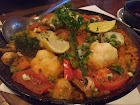In fact, things couldn't be better. The Kingdom of Denmark is considered to be the worlds most democratic and least corrupt country, it has the world's highest income equality, level of well-being and life expectancy, and the Danes are consistently ranked as the world's happiest people. And of course, it has the world's best restaurant. Noma, a portmanteau of Nodisk (Nordic) and Mad (food in Danish), has been awarded this prestigious title in 2010, 2011, 2012 and 2014 (not quite sure what happened in 2013...).
Situated in a stripped-back warehouse on the Copenhagen Dockside, Noma serves "mould-breaking Nordic food that takes natures bounty to a new level....food that makes you glad to be alive" (judge's comment, 50 Best Restaurants in the World). The cuisine is intrinsically linked to the Nordic terroir, and a re-invention and interpretation of the everyday food that the Danes love to eat.
Mealtime is very important to Danish families, as it contributes to their sense of well-being (hygge). They would typically have 3 meals a day: a cold breakfast of rye bread, cheese and jam/ a cold lunch (smorrebrod) consisting of rye bread, cold meats or smoked salmon, liver paste, cucumber and tomato, hard boiled egg and curried pickles/ and a hot dinner which may include frikadeller (meat balls), sausages, roast pork or poached cod. Denmark has a reputation of excellence when it comes to butter and cheese (think Havarti and Danish Blue). They excel in the fine art of pastry-making (what we refer to as Danish pastries, they call Wienerbrod). And they love pork (Danes eat the most pork per capita in the world).
Last night we had dinner at The Danish Club, situated on Austin Street in Newstead (3km north of the CBD). The suburb's trendy cafes and upmarket studio apartments belie its industrial past. Conveniently located on the northern bank of the Brisbane River, it once was home to timber yards, asbestos factories and wool stores, as well as Brisbane's gasworks. Today Newstead is one of the more expensive areas to purchase property in Brisbane.
There are 62,014 Danes who call Australia home, and according to Soren (Club President), about 5000 live in Brisbane. I would estimate there were about 90 enjoying the traditional Smorrebrod at the club last night. On arrival, we made ourselves comfortable at our reserved table with a couple of Carlsberg and Tuborg beers. Fact-sharing flowed freely (see blog week 1 regarding Friday Night Out Rules). It wasn't long before a queue formed at the food counter, snaking all the way to the back of the hall. Not wanting to miss out on whatever was on offer, we fell in line. What we discovered, was the renaissance of the open sandwich. Dark rye bread with a variety of mouth watering toppings:
smoked salmon with thinly sliced red onion and capers; crumbed and fried fish fillets with remoulade and lemon; roast pork with crackling, red cabbage and a slice of orange; rare roast beef with remoulade and onions; rolled and spiced pork belly; liver paste; crispy bacon, boiled egg, Danish salami, Esrom (stinky cheese) and more. The food was delicious, the beer was cold, and one could even do some shopping - does it get any better? The Danish butcher was selling a selection of premium meat products and smallgoods, Britt's Organic Bakery was there with a variety of pastries, bread and biscuits, and one could also buy imported Danish liquorice. A festive atmosphere was created by the lucky draw (9 prizes in total, with Phil and Martina both walking away as winners!), and Greg at one stage offering that he was having a ridiculous amount of fun.
So what did we learn from each other about Denmark? Martina informed us that there is no word for please in Danish; Keith had numerous facts about Lego (there is a lot to say about these little building blocks - a company worth $15 billion).We also talked bout Jorn Utzon, the architect of the iconic and Heritage Listed Sydney Opera House with its geometrically undefined curves (and how he never saw the finished building). There were facts about Hans Christian Andersen and The Ugly Duckling and the national animal, the Mute Swan. And how could we not mention our very own fairy tale: Australian born Mary MacDonald met Crown Prince Frederik in a pub during the Sydney Olympics in 2000 (can you image that introduction.....), and turned into a beautiful princess. Greg praised the virtues of Danish nannies; and Phil threw me a red herring: he told us that the famous 1967 hit Zabadak by Dave Dee, Dozy, Beaky, Mick and Tich mentioned the Skagerrak Strait in its lyrics. So here I am this morning, looking at Youtube footage of this song, only to discover that the words are gibberish, and they actually say skagalak ( to rhyme with zabadak, I assume) - and surely the last thing on Dave Dee's mind when writing the song was the body of water between Denmark and Sweden.....
So where do we go from here....ever been to Laos?














 Filip the owner of Paladar
Filip the owner of Paladar
 Louise looking quite accomplished
Louise looking quite accomplished





